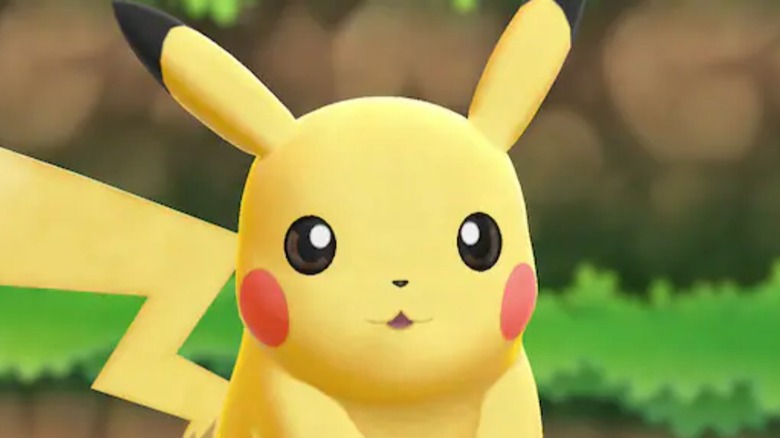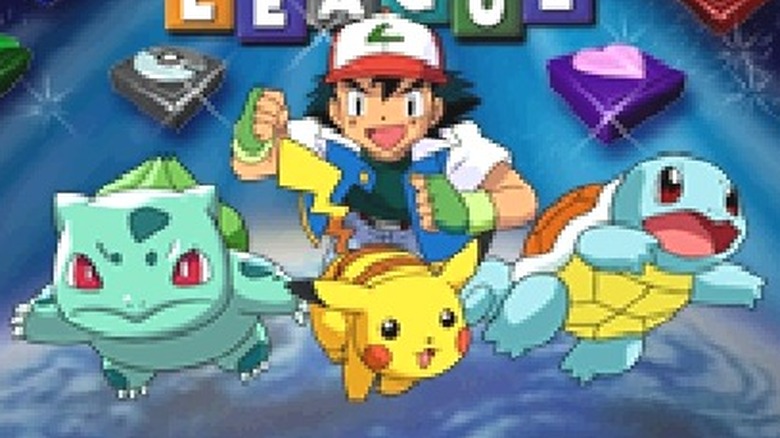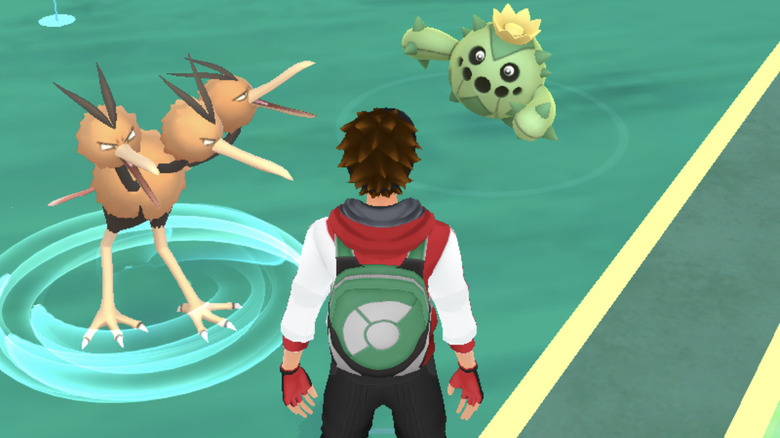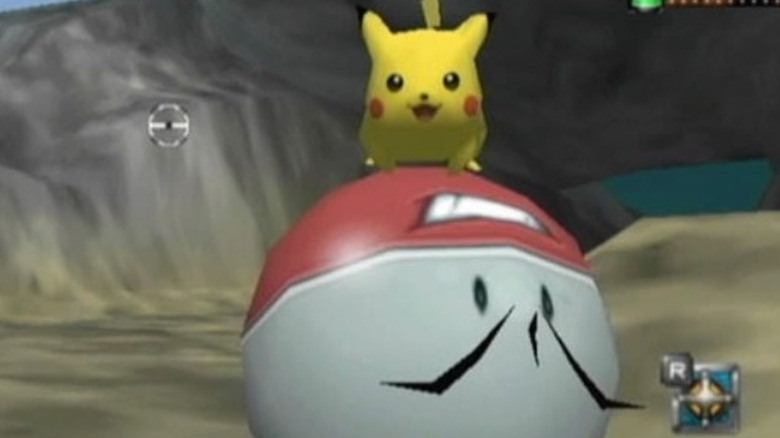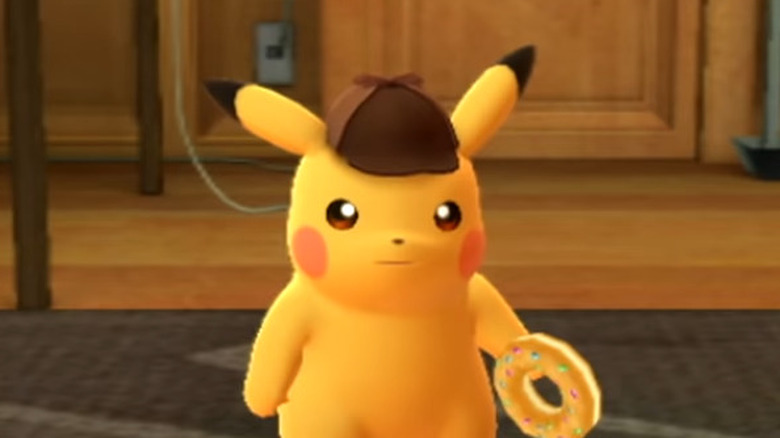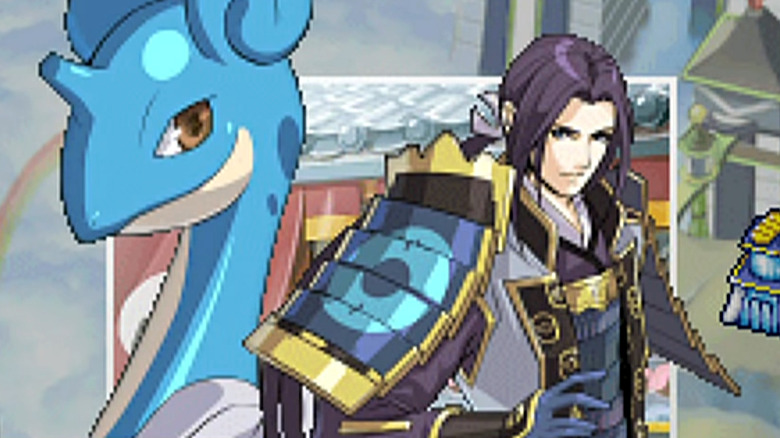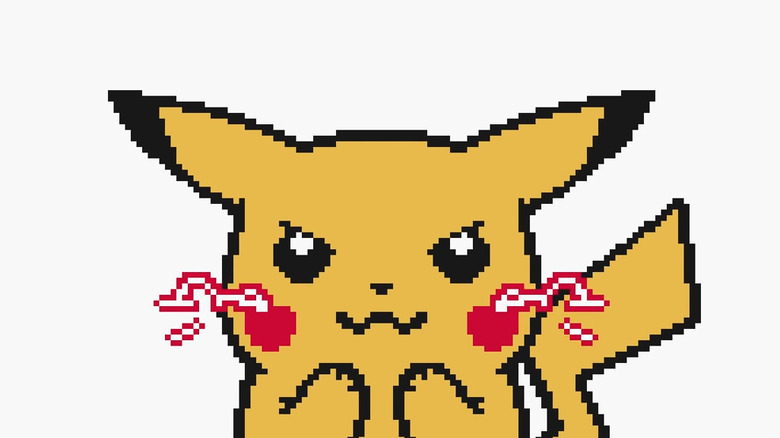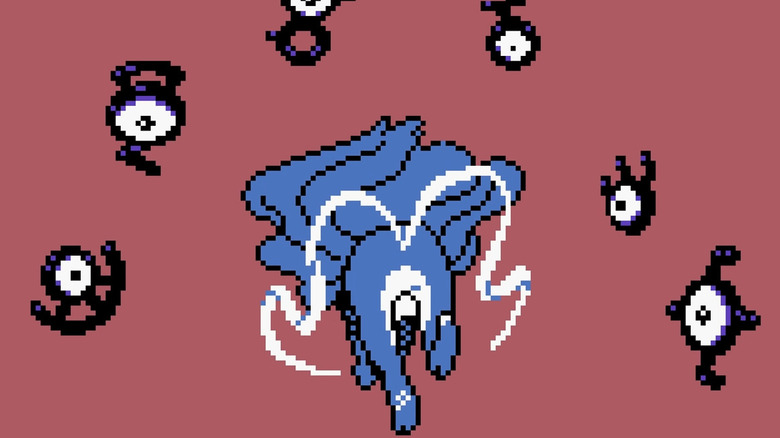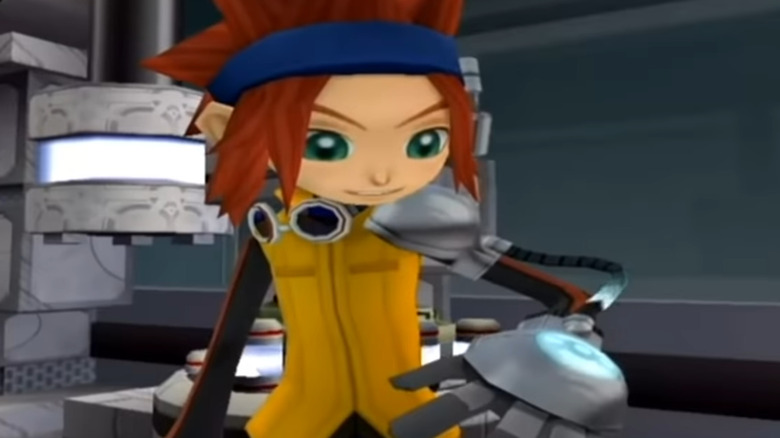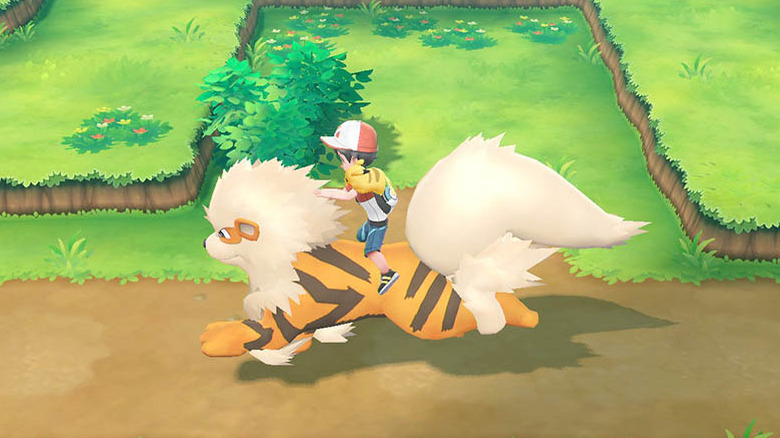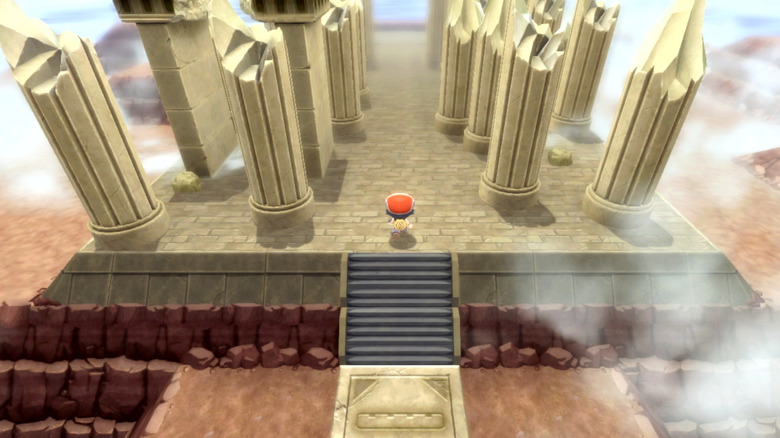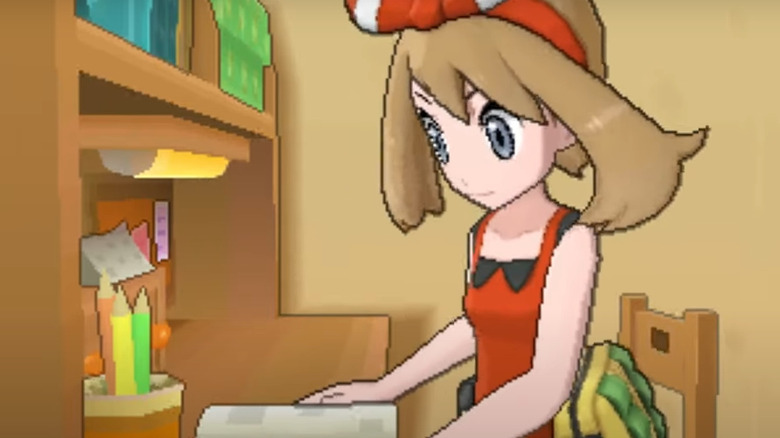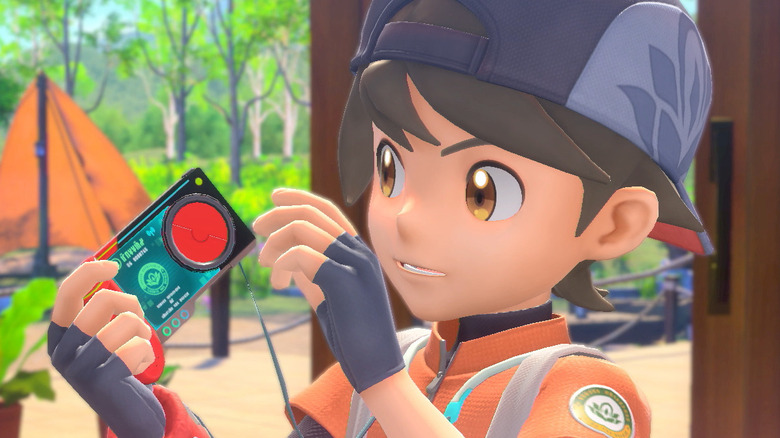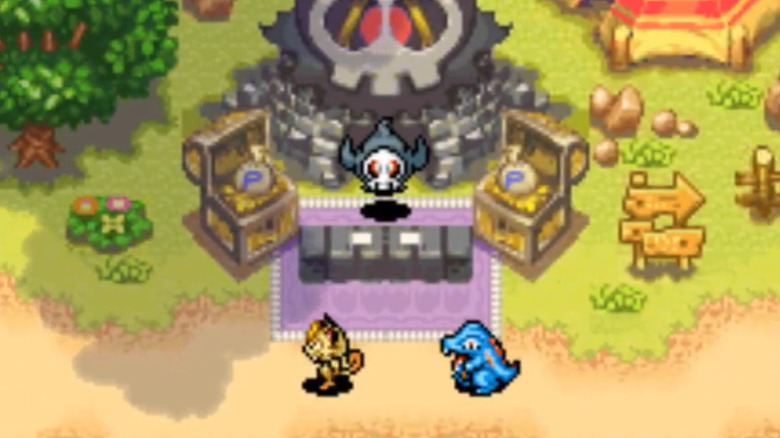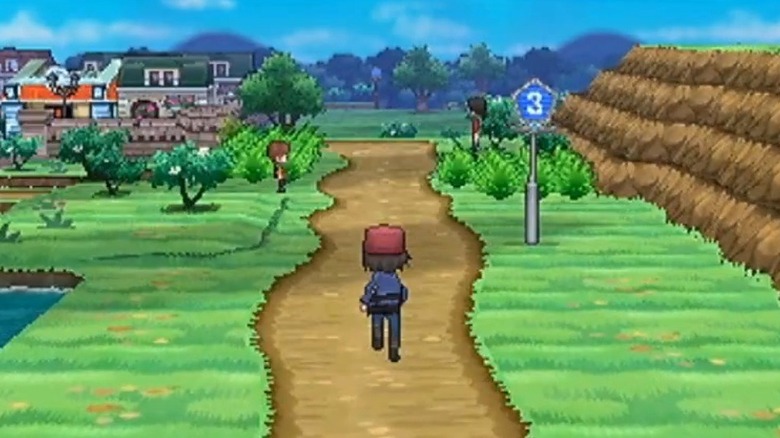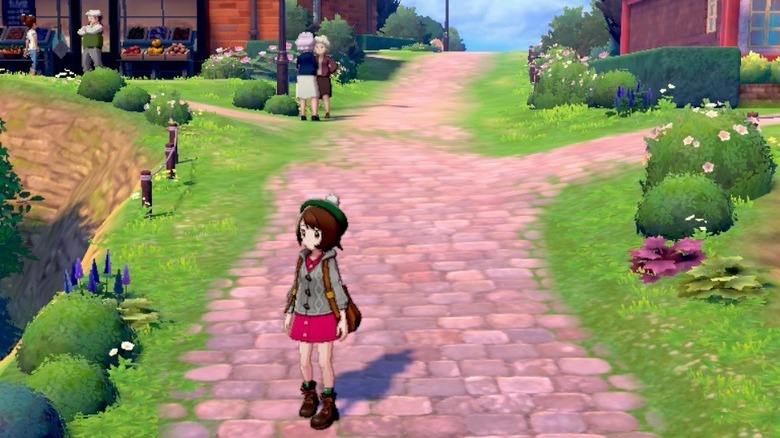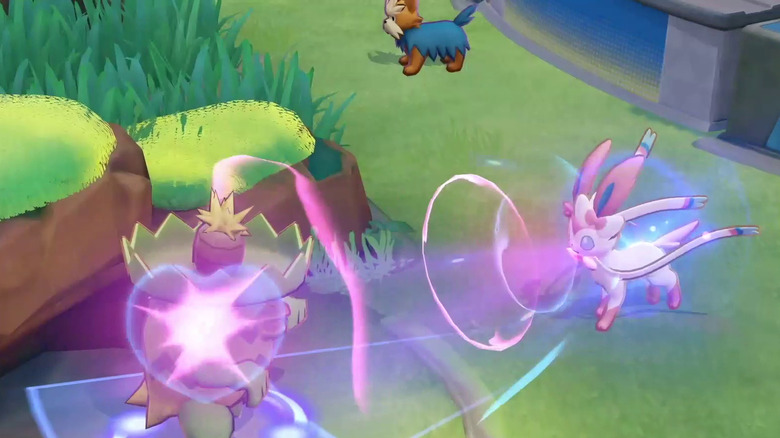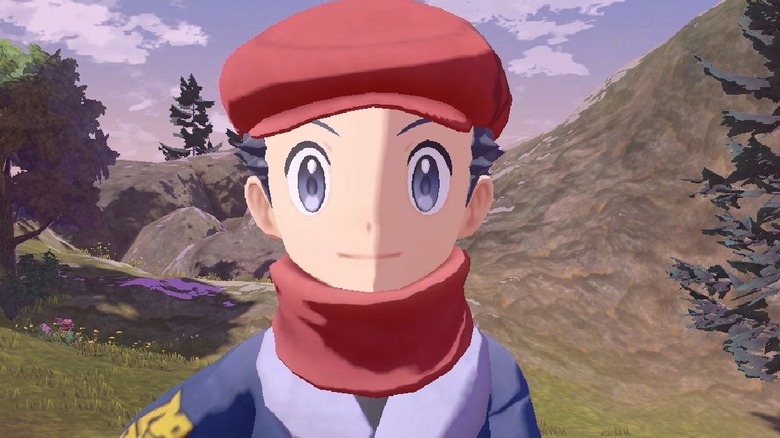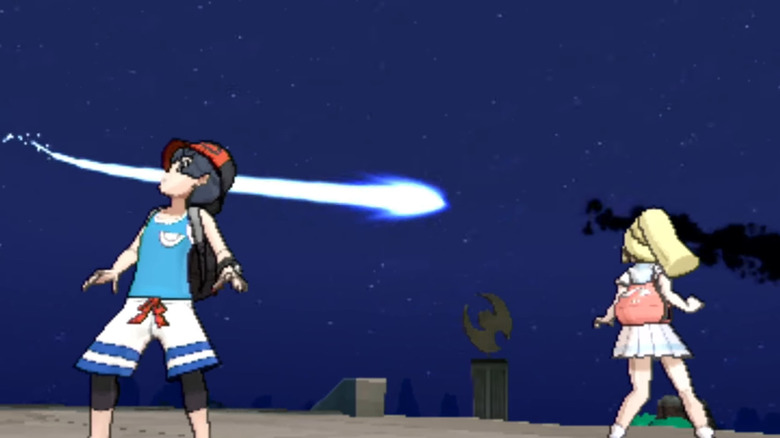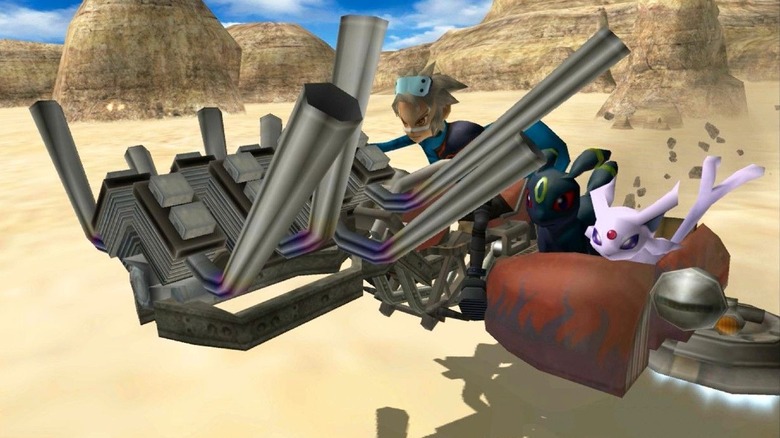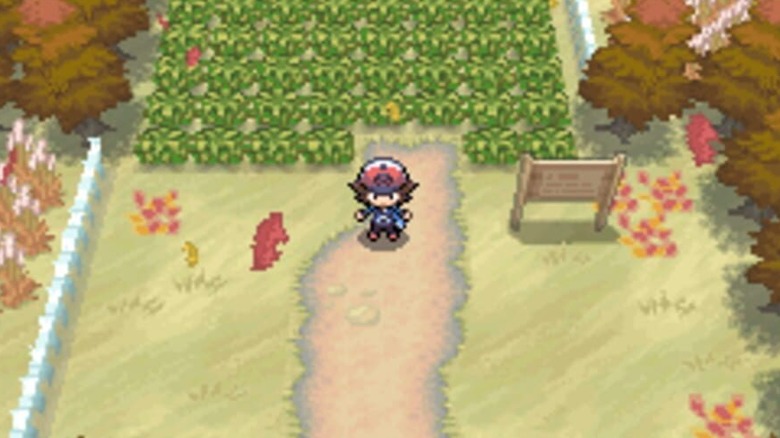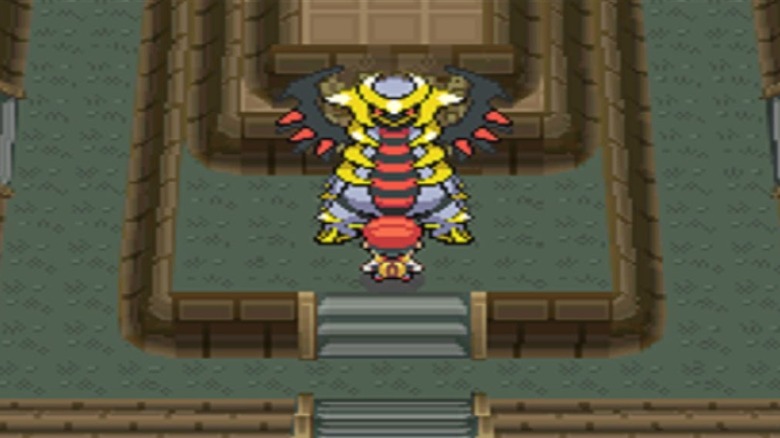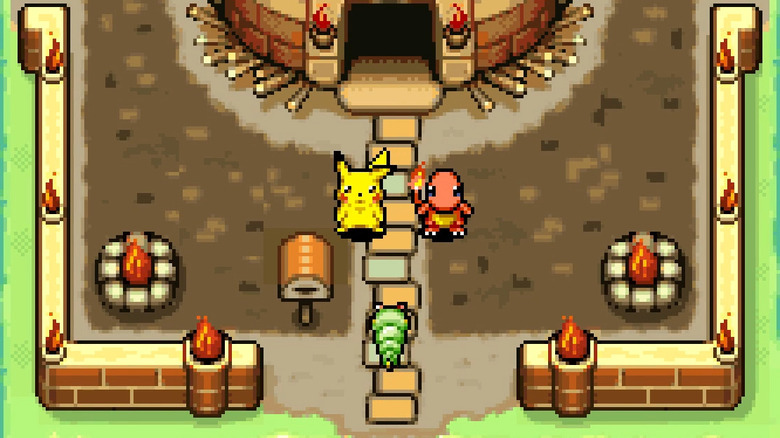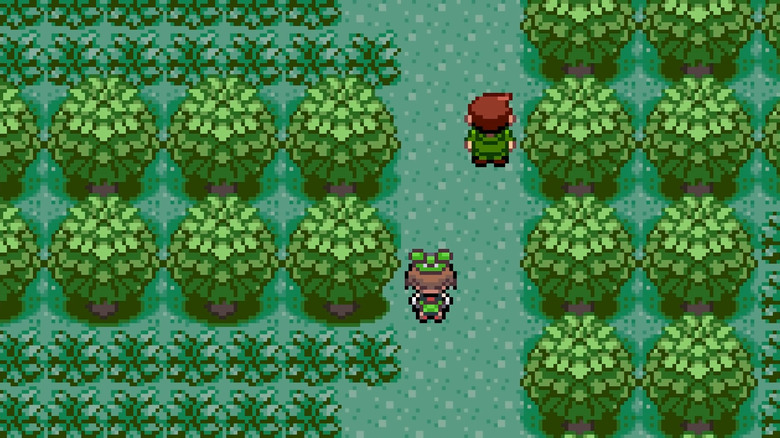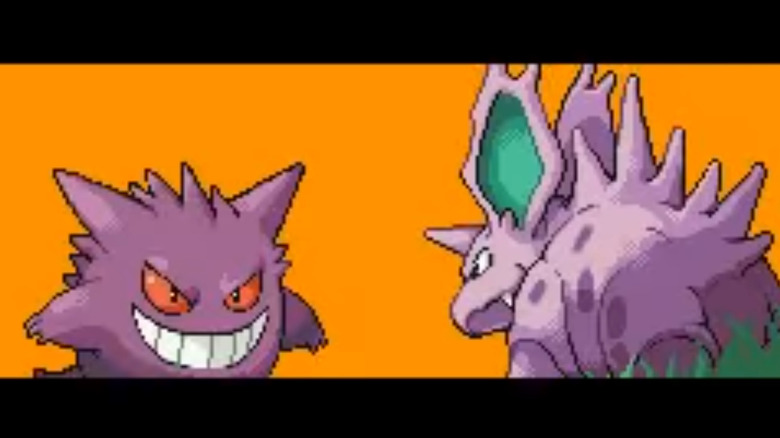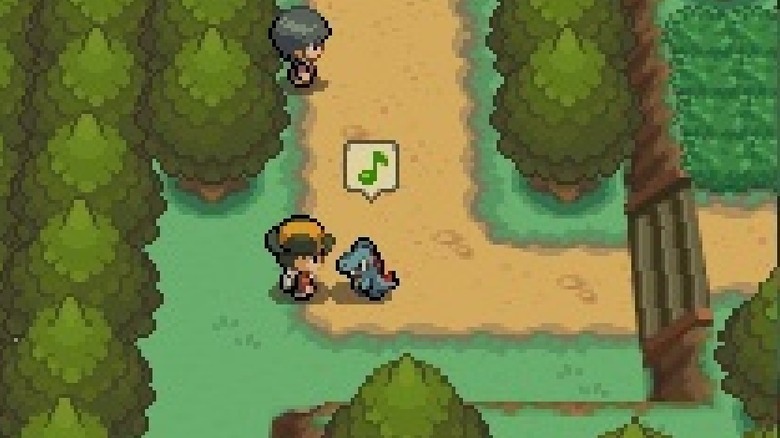25 Best Pokemon Games Of All Time Ranked
"Pokémon" challenges players to be the best, like no one ever was. No matter the game, protagonists can often be found traveling across the land, searching far and wide, and teaching Pokémon to understand the power that's inside. Pokémon!
Most core games pit the player against gym leaders and elite trainers to become the champion of each region. You build a team, train Pokémon, and progress through some sort of story. However, not all of these games stand on equal footing. That applies to the games in more than one way. Some play wildly differently — and some rank higher than others in fan appreciation. Some games in the franchise are the definition of "cult classics." Nothing is exempt from the following list, so long as it's an official "Pokémon" game. That includes the standard core series games, console spin-offs, mobile games, and more.
Here are the 25 best "Pokémon" games ranked from Not Very Effective to Critical Hit!
25. Pokemon Puzzle League
"Pokémon" meets "Tetris Attack" in "Pokémon Puzzle League," a game that involves stacking colored blocks on top of each other in matching rows and columns of at least three. Here, Ash Ketchum takes on the Pokémon Puzzle League (rather than the standard Pokémon League), where he faces Kanto gym leaders, Team Rocket, and others in block-based battles. "Pokémon Puzzle League" especially appealed to fans of the anime because it featured the dub's voice actors and made use of remixed music from the anime.
Many outlets quoted by Metacritic reviewed the game positively, saying it had the personality that "Tetris Attack" didn't. Hot Games wrote that the alternative playing options — including two-player versus mode and timed play — and the unlockable hidden characters ensured that the game never got boring. Selectable difficulty levels served to helped ramp up or lighten the challenge for those who had a harder time with the game. Still, others didn't feel the game was worth it for everyone who already had "Tetris Attack."
- Release Date: Sept. 1, 2000
- Available On: Nintendo 64
- Genre: Puzzle
- Game Modes: Single-player, Multiplayer
- Metacritic Score: 81
24. Pokemon Go
"Pokémon Go" still stands as one of the most popular and accessible Pokémon games. The ARG title was a dream come true for those who always wanted to discover Pokémon in the wild and battle gyms like in the games. It inevitably exploded into a worldwide phenomenon, encouraging people would actually come outside to play the game and bond with each other over Pokémon. Even those who didn't really like the game would be hard-pressed to deny that it led to some unique experiences not afforded by other games.
Still, virtual reality could only go so far. GameSpot called out that the game's "strengths can't hide the fact that its initial iteration is a buggy mess on all levels, from server and potential security issues to invisible trainers." Players could lose Pokémon in the middle of an encounter, which was especially frustrating, or just disconnect in the middle of doing just about anything else.
"Pokémon Go" may have a 69 as its Metacritic score, but it's hard to deny its popularity with how many people still play and care for news about the game. Developer Niantic has since fixed many of the broken features and introduced engaging new additions that enhance the experience and regularly draw in new players.
- Release Date: July 6, 2016
- Available On: Android, iOS
- Genre: Augmented reality mobile game
- Game Modes: Single-player, Multiplayer
- Metacritic Score: 69 (iOS)
23. Pokemon Snap
"Pokémon Snap" introduced a new kind of on-rails shooter. Players spectated sceneries like a safari rather than battleground where players simply blasted enemies that popped up throughout the course. Instead of guns, they shot with cameras. Players photograph Pokémon and solved puzzles involving them to progress in the game. Of course, that made for amusing and often entertaining interactions that the player could initiate with items. It also meant plenty of mischief, like bonking Pokémon on the head with apples or nabbing them with Pester Balls to get the perfect shot.
Critics loved the game, with GameSpot especially praising the character models, animations, and sound design that included voices from the anime. "Pokémon Snap" is a compact game that can be finished in 20 or so hours without needing to endlessly replay courses. Still, players can take satisfaction in snapping the same scenarios to improve quality with centering the shot and getting a large enough photo.
"Pokémon Snap" became such a beloved classic that Nintendo eventually decided to follow up with a sequel that greatly differed from the original. This game might not be as popular as this newest iteration, but it deserves recognition for its inventive concept and endearing Pokémon interactions.
- Release Date: June 30, 1999
- Available On: Nintendo 64
- Genre: Adventure, Puzzle, Rail Shooter
- Game Modes: Single-player
- Metacritic Score: 77
22. Detective Pikachu
Did you know that "Detective Pikachu" was a game before it was a movie? It follows much the same plot: Tim Goodman is looking for his missing father when he comes across a snarky talking Pikachu who acts like a middle-aged man. Tim and Detective Pikachu work together to gather clues, with Tim acting as a translator for Pikachu and Pikachu talking to Pokémon and relaying the information for Tim. Some people might think it's a bit uncouth for Pikachu to be weirdly flirty to female side characters, but hey.
"Detective Pikachu" features a charming story that approaches Pokémon from a different angle than the typical trainer relationship. IGN praised "Detective Pikachu" for expanding on relationships between people and Pokémon outside of gym battles, and noted that the puzzles were reasonable for younger audiences without being tedious for older players. The fact that the Pokémon Company agreed to make it into a film starring Ryan Reynolds should be reason enough to revisit this gem.
- Release Date: March 23, 2018
- Available On: Nintendo 3DS
- Genre: Adventure, Puzzle
- Game Modes: Single-player
- Metacritic Score: 71
21. Pokemon Conquest
"Pokémon Conquest" mixed two seemingly unrelated concepts into an unlikely spinoff. Instead of collecting gym badges and Pokémon, players battle against Japanese warlords in turn-based combat. It's a crossover between "Pokémon" and "Nobunaga's Ambition," a strategy RPG series set in feudal Japan, and follows the gameplay loop from that series. Osamu Mieda, the game's producer, had previously worked on the "Nobunaga's Ambition" series before working on "Conquest." Tsunezaku Ishihara, CEO of The Pokémon Company, apparently pitched the idea because he really enjoyed the former games.
"Conquest" didn't hit it off with western audiences as much as it did in Japan, considering the Japanese history backing its premise. However, the game pulls off the strategy elements well, offering players opportunities to level up Pokémon, rest in a secret base, and more RPG mainstays. In short, it was more like a strategy RPG with a "Pokémon" skin, rather than something built from the ground up as a recognizable "Pokémon" game. Bizarre mash-up concept aside, those who have played it had to give it props for its enjoyable gameplay.
- Release Date: June 18, 2012
- Available On: Nintendo DS
- Genre: Strategy RPG
- Game Modes: Single-player
- Metacritic Score: 80
20. Pokemon Red/Blue/Yellow
"Pokémon Red" and "Blue" were the games that started it all. Professor Oak gives a young trainer their first Pokémon and asks them for help completing the Pokedex during their journey to the Pokémon League. These classic games feature the first 150 Pokémon and challenge players to "catch 'em all," especially with friends. "Red and Blue" often brought people together through trading and Pokémon battles, which they could do via link cables for the Game Boy Color.
Then, "Pokémon Yellow" built on the base game with a fun surprise that made it even better: a Pokémon that followed you around! Trainers received a Pikachu that refused to stay in a Poke Ball instead of one of the three standard Kanto starters. Even better, players could talk to Pikachu! It reacted differently based on its status condition and friendship level with the trainer. "Pokémon Yellow" took inspiration from the anime, which also starred a Pikachu who disliked Poke Balls.
"Pokémon Red," "Blue," and "Yellow" aren't as advanced as newer games in terms of graphics and gameplay, so they rank a bit lower on the list. Still, Pokefans can't help but fondly remember how enjoyable and revolutionary they were at the time.
- Release Date: Sept. 28, 1998 (Red/Blue), Oct. 19, 1999 (Yellow)
- Available On: Game Boy Color
- Genre: RPG
- Game Modes: Single-player, Multiplayer
- Metacritic Score: N/A
19. Pokemon Gold/Silver/Crystal
"Pokémon Gold" and "Silver" stepped up as the second generation after the ever-popular Kanto region. "Pokémon Crystal," much like "Pokémon Yellow," mostly added quality-of-life changes to the two base titles, such as the inclusion of the first female player character, Crystal. As noted in IGN's review, these games introduced Dark and Steel types, day and night cycles, Pokémon breeding, and many other now-standard features in the series that first succeeded at this point.
Another reason "Gold and Silver" stand above the first generation is their endgame content, which includes the same locations as "Pokémon Red" and "Blue." After defeating all the Johto gym leaders and the Silver Conference (the region's version of the Pokémon League), champions earned access to Gen 1's Kanto region via cruise ship. They could then battle all the Kanto gym leaders and enter the Pokémon League, which extended the experience with nearly another full game's worth of content and made the two regions feel more connected to each other.
These games received high ratings from accredited gaming sites like IGN and GameSpot at the time of their release. Also, just as a note: the sparkly silver, gold, and blue translucent cartridges for "Gold," "Silver," and "Crystal" were just cool.
- Release Date: Oct. 15, 2000 (GS), July 29, 2001 (Crystal)
- Available On: Game Boy Color
- Genre: RPG
- Game Modes: Single-player, Multiplayer
- Metacritic Score: N/A
18. Pokemon XD: Gale of Darkness
"Pokémon XD: Gale of Darkness" carries over the same pros as its predecessor, "Pokémon Colosseum." It's placed in a darker setting with Shadow Pokémon, who have had their hearts "artificially closed." Team Cipher, the main antagonistic force in the game, plans to use these brainwashed Pokémon to take over the Orre region. In "Gale of Darkness," an average boy is suddenly put in charge of a Snag Machine — a special device used for stealing Pokémon — and uses it to capture Shadow Pokémon and purify them on his journey to save his kidnapped mentor.
"Pokémon XD" introduces more Pokémon than "Colosseum," adds quality-of-life improvements, and reimagines the same regions in its story. For example, YouTuber JPRPokeTrainer98 highlights how the purification chamber vastly improved the game from the more tedious process used in "Colosseum." Still, some critics have rated this sequel lower than "Colosseum" because they believed it reused too many of the same ideas to be worth another play. There's also arguably less depth to the relationships between characters and the backstory of the protagonist.
- Release Date: Sept. 28, 2005
- Available On: GameCube
- Genre: RPG
- Game Modes: Single-player
- Metacritic Score: 64
17. Pokemon: Let's Go, Pikachu! and Let's Go, Eevee!
"Pokémon: Let's Go, Pikachu!" and "Let's Go, Eevee!" bring players back to Kanto in a more interactive adventure. Fans of the series should notice that these follow the general story for "Pokémon Red" and "Blue" and even adapts features like partner Pokémon from "Pokémon Yellow." However, they aren't straight-up remakes like "Pokémon FireRed" and "LeafGreen." The "Let's Go" games exist as RPGs that are meant to connect with "Pokémon GO" fans, as in-game events often tie in with each other. For instance, "Pokémon GO" players could expect bonus Pokémon and such from owning either game.
Critics generally enjoyed the "Let's Go" titles, but as they targets casual players who would be likely to play "Pokémon Go," they aren't as difficult as the typical core series titles. The 3D graphics and interactions add an appreciated layer of graphical cuteness and modern feeling, but those bells and whistles may not be enough to hold a player's attention.
16. Pokemon Brilliant Diamond and Shining Pearl
"Pokémon Brilliant Diamond" and "Shining Pearl" remake the Sinnoh generation games, which focus on the time-space bending Legendary Pokémon Dialga and Palkia. Players must prevent Team Galactic from summoning legendary Pokémon to recreate the universe while battling their way to the Sinnoh League.
Many critics enjoyed the games, giving them credit for their quality-of-life improvements and chibi art style. Even so, some argued that these facelifted versions didn't innovate enough on the original games to warrant buying a fully-priced copy. In short, critical reception didn't quite land as well as the first few remakes for the Kanto and Johto generations. Sinnoh fans still seemed to overall enjoy the remakes, though it's hard not to sympathize with those who've pointed out that even some glitches still work from the original games.
While these might be the most recent remakes in the "Pokémon" series, it's hard to justify ranking them higher.
- Release Date: Nov. 19, 2021
- Available On: Nintendo Switch
- Genre: RPG
- Game Modes: Single-player, Multiplayer
- Metacritic Score: 73 (Brilliant Diamond), 73 (Shining Pearl)
15. Pokemon OmegaRuby and AlphaSapphire
"Pokémon Omega Ruby" and "Alpha Sapphire" remake an adventure in what might be the most geographically diverse region in the series. Players cross craggy mountains, soot-covered lands under a volcano, and vast seas — possibly because of the climate-obsessed Team Magma and Team Aqua. Team Magma wants to transform the earth into a solid block of land, while Team Aqua wants to overtake it with water. Sure, it's not too complicated of a plot, but it's enough that the gameplay can still carry trainers all the way to the end.
Critics were especially vigilant about next-gen quality, considering "Pokémon X" and "Y" released only the year before. Thankfully, these remakes pulled through. Sites like Nintendo Life agreed that DexNav, Pokenav Plus, and other fun new additions put it a tier above the original games. Also, the modern features from "Pokémon X" and "Y" made it pop. Polygon praised the visual overhaul, Player Search System, and Mega Evolutions originally introduced in "X" and "Y," all of which saw improvements in the Hoenn remakes.
- Release Date: Nov. 21, 2014
- Available On: Nintendo 3DS
- Genre: RPG
- Game Modes: Single-player, Multiplayer
- Metacritic Score: 83 (Omega Ruby), 82 (Alpha Sapphire)
14. New Pokemon Snap
"New Pokémon Snap" follows a similar play style as its ancestor. However, it takes things a step further with a ton more Pokémon interactions and many other differences. Instead of working for Professor Oak, the protagonist aids Professor Mirror in his research on Illumina flowers across the Lental Region. It almost served as the new vacation game after "Animal Crossing: New Horizons," offering equally creative sceneries and adorable creatures.
Like its predecessor, "New Pokémon Snap" offered entertaining interactions between Pokémon, including elusive secret shots and unsettling moments to discover. Outlets like TheGamer have noted the grindy, repetitive nature of raising course levels and capturing all the different star photos. However, it still offered a mostly enjoyable experience with lots of Pokémon to photograph and beautiful courses that crossed a variety of different landscapes.
- Release Date: April 30, 2021
- Available On: Nintendo Switch
- Genre: Adventure/Rail Shooter
- Game Modes: Single-player
- Metacritic Score: 79
13. Pokemon Mystery Dungeon: Explorers of Time and Explorers of Darkness
"Pokémon Mystery Dungeon: Explorers of Time" and "Explorers of Darkness" followed the first pair of "Pokémon Mystery Dungeon" games with a new pair of characters. Legend has it that time stops in a specific region if someone steals its Time Gear, a chronology-controlling artifact that enables the flow of time in its particular area. Strange time shenanigans imply your character might have more power than they realize.
Critics weren't too impressed with these games, as they played mostly similar to the original pair of games, just with a few additions. For example, outside of the new wi-fi functionality, Eurogamer didn't see much of a reason for playing these if you'd already played "Pokémon Mystery Dungeon: Blue Rescue Team" or its counterpart. Those who rated the game higher, such as Nintendo Power (via Metacritic), praised the story as a major strength that followed in the steps of the original.
It's worth noting that the Metacritic user score for both "Pokémon Mystery Dungeon" titles are overwhelmingly positive in comparison to their critic scores. However, many seem to agree that didn't have as many twists or emotional depth as the first games, which puts it at a lower tier.
12. Pokemon X and Y
"Pokémon X" and "Y" featured fashion-friendly bosses looking for chaos in Kalos, a region based on France. These titles mostly follows the same rules as the other games, in which players train a team to take on the Pokémon League and collect monsters on behalf of the regional professor.
In addition to the core gameplay and story, customization options and graphics were on point. "Pokémon X and Y" were the first pair of games that featured a mostly 3D experience, which helped modernize it and set it apart from the previous top-down "Pokémon" games. However, the story and Legendaries didn't tend to grab players in the same way the Kanto or Sinnoh games dud. In short, these brought a much-welcomed upgrade, even though they didn't offer much in the way of a memorable villain or gym leaders — at least, not in the same way past games did.
11. Pokemon Sword and Shield
"Pokémon Sword" and "Shield" grounded players in the Galar region, which boasted plenty of British references, from open fields full of Wooloo to a Big Ben-like clock tower. Like with "Sun" and "Moon," the game removed the need for so-called "HM slaves" and random encounters. However, some Pokefans had issues with the new games.
First off, the devs took away the national Pokédex that many players appreciated for truly allowing them to "catch them all." Second, the games didn't have as challenging a rival, who also had a first Pokémon with a type disadvantage against your starter and made you feel bad about beating him because he's a little boy with a confidence problem instead of a name-calling jerk. Also, there was little to no endgame besides the Battle Tower with the regional champion. Expansion DLCs add more Pokémon and a sizeable region for exploration after defeating the League, but they cost money.
"Pokémon Sword" and "Shield" still work as "Pokémon" games by convincing players to catch 'em all once again. However, they didn't enrapture players the same way as the old games did. Also, there was no way to transfer Pokémon from old games, which rubbed players the wrong way after they were spoiled by the national 'dex from "Sun and Moon."
10. Pokemon UNITE
Fans often find it easy to summarize "Pokémon Unite" as "'League of Legends' but with Pokémon." Players form teams of six made up of select Pokémon that fit into defender, attacker, support, and all-rounder roles. They must then work together to destroy enemy goals and defend their own. Bosses pop up throughout the match, which require some coordination to beat. Players also need to fight wild Pokémon to collect points for scoring goals. Alternatively, they can knock out opposing players to take their points.
Of course, it isn't perfect. Nintendo Enthusiast has pointed out the unbalanced characters on the roster, some of which are much stronger than others. Some, like GameSpot, have a problem with the progression system that incentivizes players to spend money on held items. "Pokémon Unite" might not be for hardcore MOBA players, but it's a perfect introduction to the genre for "Pokémon" fans and those who don't mind its unorthodox ranked mode.
- Release Date: July 21, 2021 (Switch), Sept. 22, 2021 (Mobile)
- Available On: Nintendo Switch, Android, iOS
- Genre: MOBA
- Game Modes: Single-player, Multiplayer
- Metacritic Score: 70 (Nintendo Switch)
9. Pokemon Legends: Arceus
"Pokémon Legends: Arceus" transports players to the Hisui region, a feudal era, open-world counterpart to modern-day Sinnoh. The player, who falls out of a wormhole in the sky, joins the Galaxy Expedition Team after a surprise encounter with Professor Laventon reveals their legendary Pokémon-capturing skills. In addition to witnessing Sinnoh's history, they help to calm political conflict between the Diamond and Pearl Clans and solve the mystery behind their appearance in Hisui.
"Pokémon Legends" is one of the most ambitious "Pokémon" spinoffs in years. Its gameplay riffs on the age-old turn-based combat of the average "Pokémon" game and combines it with real-time strategy considerations. The title also introduces crafting, dodge rolls, and other action RPG elements that separate it from the monotonous grind of gym battles. Story-wise, it paints the clearest picture of life in Sinnoh before the era of "Pokémon Diamond" and "Pearl." Players get front row seats to humans' growing appreciation for Pokémon and the lore related to legendaries like Shaymin. In short, it's satisfying and fresh for both newcomers and fans alike, already earning it a high ranking on this list.
Release Date: Jan. 28, 2022
Available On: Nintendo Switch
Genre: RPG
Game Modes: Single-player
Metacritic Score: 82
8. Pokemon Sun and Moon
"Pokémon Sun" and "Moon" focus on exploration more than the typical Pokémon League takedown. These games appeal to both newbies and veterans with a revised UI system that teaches type advantages and brings back familiar characters in new forms. Of course, there's Red and Blue from the original games, but Pokémon also received alternate looks. For example, Alohan Vulpix resembles a fluffy white Vulpix with wispier fur — and fights as an Ice type instead of a Fire type.
"Sun" and "Moon" revolutionized the series with a different approach to exploration, which showed Pokémon clearly wandering in grass instead of hitting players with random encounters. They also first removed the need for HM slaves with a revamped travel system. No more teaching Pokémon to permanently Surf or Fly just to get around. Mechanics like these carried over to later games. "Sun" and "Moon" didn't have much of a game-changing story, but they were more game-changing (or series-changing) in the literal sense.
7. Pokemon Colosseum
"Pokémon Colosseum" takes a darker approach to the series with a plot revolving around brainwashed Pokémon. The antihero protagonist rescues a psychic girl from the villainous Team Snaggem, his old employer, and the two of them embark on a quest to free Shadow Pokémon from their trainers and purify their hearts. She identifies the Shadow Pokémon and he steals them from their trainers. These Pokémon have had their hearts darkened, and players can only purify them after depleting their shadow gauge with friendship and bringing them to a Celebi-blessed fountain.
"Pokémon Colosseum" stands out with its striking premise, which offers a near-dystopian alternate to the "Pokémon" world outside of just gym battles, set in a new region with a completely different goal. Some of the appeal comes from stealing Pokémon, which players have never been able to do in the core games. Plus, most matches are played in double battles in the titular Colosseums around the region. In short, "Pokémon Colosseum" excited players as another piece of the Pokémon world that did something very different. It also introduced an interesting enough concept to warrant a sequel.
- Release Date: March 22, 2004
- Available On: GameCube
- Genre: RPG
- Game Modes: Single-player
- Metacritic Score: 73
6. Pokemon Black and White
"Pokémon Black" and "White" were the first games in the franchised based on a location other than Japan. Unova used New York City as an inspiration, though the Pokémon themselves worked the same as they always did. Unlike past titles, "Black" and "White" featured exclusively completely new Pokémon — no Pidgeys, Magikarp, or any older 'mons in the wild.
"Black" and "White" especially stood out to fans because of their morally gray story. This time, the villains weren't just criminal organizations and environmental terrorists. In fact, the villains kind of had a point. Team Plasma and their leader, N, wanted to free Pokémon from humans. No more battling, imprisonment, or any sketchy slave-like practices. However, N learns along the way that trainers' relationships with their Pokémon aren't so one-sided. Many fans still consider him to be one of the most well-written villains in the series.
"Pokémon Black and White 2," the sequels to the game, continued the story of Team Plasma and brought back N. Though the sequels weren't as well-received, these games are notable for earning a follow-up that expanded on the story.
5. Pokemon Diamond/Pearl/Platinum
"Pokémon Diamond" and "Pearl" were the first mainline Pokémon games to lean more into 3D models. At their core, "Diamond" and "Pearl" didn't really shake things up in terms of gameplay or story. You still capture as many Pokémon as possible and raise an elite team to take on gym leaders and champions. Players find out what the new domestic terrorist organization, Team Galactic, has in mind for Sinnoh. Sure, it has some 3D effects, but nothing that really sets it apart from the older games. However, these games take those familiar elements and make them sing.
One of the most game-changing additions? The Global Trade Station, which allows players to use wi-fi to connect and list Pokémon for a trade. Players can randomly trade Pokémon and see what they receive in the Russian roulette too. This game also added secret bases, which players could visit with a wifi connection or when connecting with a friend in person. Finally, players can decorate the hideout with furniture and plush toys, as well as sift through dirt for gems. All of these enhancements set "Diamond" and "Pearl" apart.
4. Pokemon Mystery Dungeon: Blue Rescue Team and Red Rescue Team
"Pokémon Mystery Dungeon: Red Rescue Team" and "Blue Rescue Team" became cult classic favorites thanks to their emotionally appealing story. An amnesiac protagonist wakes up as a Pokémon in a town in which Pokémon form rescue teams to aid others in distress. Natural disasters have become more frequent in this world, and so it's up to these teams to save those caught up in trouble. A timid but kindhearted bystander teams with the protagonist to form a new rescue team, embarking on an adventure to uncover the truth behind the protagonist's lost memories.
These titles don't follow the same monster-catching mechanics as the core series, instead dropping players into dungeons that they have to fight their way through in a roguelike fashion. Maps can significantly differ depending on the run. Also, when players wipe out, they need to enlist help from friends with rescue codes if they want to keep their items and place in the dungeon. Thankfully, these codes could be distributed to friends or over the internet without actually having to connect to the other world.
Critics knocked the games for their repetitive dungeon mechanics, but fans still love the pair for the heartwarming and unique story.
- Release Date: Sept. 18, 2006
- Available On: Nintendo DS, Game Boy Advance
- Genre: RPG, Roguelike, Dungeon Crawler
- Game Modes: Single-player
- Metacritic Score: 62 (Nintendo DS), 67 (Game Boy Advance)
3. Pokemon Ruby/Sapphire/Emerald
"Pokémon Ruby" and "Sapphire" are possibly the most geographically diverse games, which further ties the element-obsessed villains into the plot. In the quest to beat Team Magma or Team Aqua, players cross craggy mountains, soot-covered lands under a volcano, vast seas, and more. Hoenn introduces new Pokémon, sure, but it also offers more than Kanto and Johto towns did in terms of their geography, which were both mostly urban environments sandwiched between forests.
Many rate the third game in the generation, "Pokémon Emerald," higher than "Ruby" and "Sapphire" because of its addition of the Battle Tower, an arena unlocked after a victory over the Pokémon League. Still, a significant number of outlets have noted that it ultimately didn't change much from "Ruby" and "Sapphire," finding the extra battles to be more of a "just for fun" addition for those who could afford to invest in another cartridge.
2. Pokemon FireRed and LeafGreen
"Pokémon FireRed" and "LeafGreen" were the first-ever remakes of older "Pokémon" games, and the developers knocked it out of the park. These GBA games remade the original "Pokémon Red" and "Blue" with higher quality colored sprite art, fluid gameplay and animations, and more content than their predecessors.
The endgame content is especially notable. One of the ways in which "Pokémon Gold" and "Silver" built on "Pokémon Red" and "Blue" was with its postgame that included a whole other region with Pokémon from the past generation. "FireRed" and "LeafGreen" did the same thing with the addition of the Sevii Islands, post-game regions that gave players a roomy new area to explore after defeating the Pokémon League and a place to capture Pokémon from other lands.
Players with "Pokémon Ruby," "Sapphire," and "Emerald" could also trade and battle with this generation of players. Plus, not only did the new Pokédex include the first 150 Pokémon — it included up to the Hoenn region!
1. Pokemon HeartGold and SoulSilver
Last but not least: "Pokémon HeartGold and SoulSilver." These are objectively two of the most beloved games of the core series. First off, as you might guess from the titles, they remake "Pokémon Gold" and "Silver," which are set in the fan favorite Johto region. They also innovate from the original games and, like "FireRed and LeafGreen," feature an excellent endgame that allows players to catch Pokémon from other regions. Of course, because these were released nearly a decade after the original games, the pair of remakes brought plenty of quality-of-life changes like improved sprites, animation, and more.
"HeartGold" and "SoulSilver" also brought back the highly requested feature of companion Pokémon, meaning the first Pokémon in your party can walk alongside you outside of its Poké Ball. This mechanic worked very much like in "Pokémon Yellow," in which Pikachu closely followed the trainer and reacted to them differently based on status condition and friendship level. Players could also speak to their Pokémon to gauge their friendship level. While not a crucial addition to the game, the Pokéwalker also added some novelty with the option to level up Pokémon based on a pedometer-like step counter. These innovations and more make "HeartGold" and "SoulSilver" into stone cold classics.
- Release Date: Sept. 12, 2009
- Available On: Nintendo DS
- Genre: RPG
- Game Modes: Single-player, Multiplayer
- Metacritic Score: 87 (HeartGold), 87 (SoulSilver)

